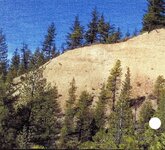G
ghostminer
Guest
Upvote
0
If I am not wrong I think mineral crystals, flourite included, are formed under intense pressure and heat.

Really.https://en.wikipedia.org/wiki/Newbery–Vautin_chlorination_process
Leaves purple residue.

Thanks for all that. No, we don't have to build the bluff face back. The area I was talking about with the purple material is a creek bluff. We have no interest in that area for now. We are permitted in the mining district 1/2 mile east of there. There is an exposed faultline richer than snot. Then there is another mine 2000 ft east which was partially hydraulicked with 1 million yards of pay left over in the gut of the channel. That 1 million yard figure only counts the pay streak which is about 40 ft thick from bedrock. The historical averages are 50 yds to the oz with best at bedrock but not always. I actually have a letter from the mining company from the 1800's describing what they were getting & they were hitting pay at various levels. They had trouble mining very far into summer as the flumes dried up. We are starting on the exposed material on the faultline as there is no overburden to deal with. We have about 50,000 yards of it & that should fund phase 2 at the big bluff. It better or I'm screwed LOL. Everything I own is riding on it. No guts, no glory. View attachment 1535211